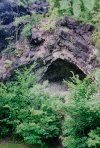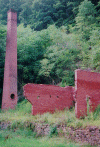 |
116.04 |
09-Aug-98 |
Licking Creek Aqueduct (No. 6), said to be the largest single arch built in the
U.S. Built from 1835-39 of inferior limestone, which was already beginning to deteriorate by
1870. Now stabilized with iron ties and clamps. |
 |
118.46 |
09-Aug-98 |
Waste weir, unusual in that it drains from the berm side of the canal into a
culvert. Waste weirs were used to drain excess water from the canal into the Potomac. |
 |
122.51 |
09-Aug-98 |
Me, at Lock 51 |
 |
122.59 |
09-Aug-98 |
Stone of Lock House 51. The inscription on the stone reads D.R. 1843,
surrounded by a row of Xs and stars. Upton Rowland was the locktender here from 1840 to
1848. |
 |
122.89 |
09-Aug-98 |
Lock No. 52, with Tonoloway Creek Aqueduct in the background. |
 |
122.89 |
09-Aug-98 |
Flowers at the edge of Lock No. 52. |
 |
122.96 |
09-Aug-98 |
Little Tonoloway Creek aqueduct (No. 7). |
 |
125 |
09-Aug-98 |
Great blue heron in canal bed near Hancock. |
 |
126 |
09-Aug-98 |
Towpath near Hancock. |
 |
127.4 |
09-Aug-98 |
Cement kilns (five of eight) at Round Top Cement Mill. |
 |
127.4 |
09-Aug-98 |
Round Top Cement Mill. Began operating in 1837, burned in 1903, rebuilt,
and
finally closed in 1909. |
 |
127.4 |
09-Aug-98 |
Rock formation near Round Top Cement Mill. |
 |
127.4 |
09-Aug-98 |
Chimney and part of the walls of the Round Top Cement Mill. |
















